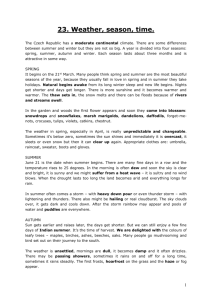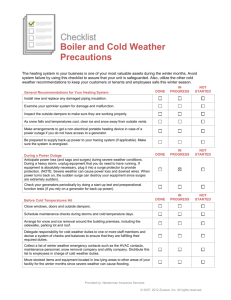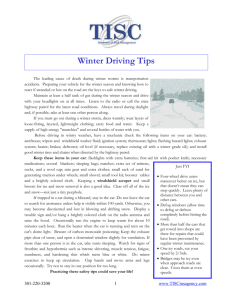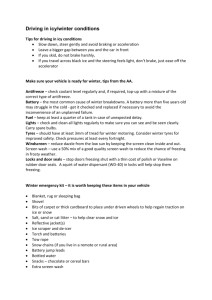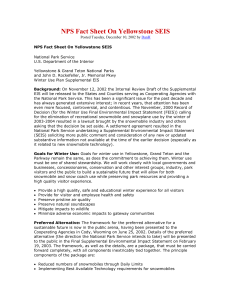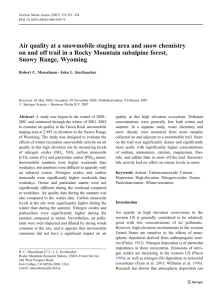Snowmobile Rules, Ethics, and Safety
advertisement
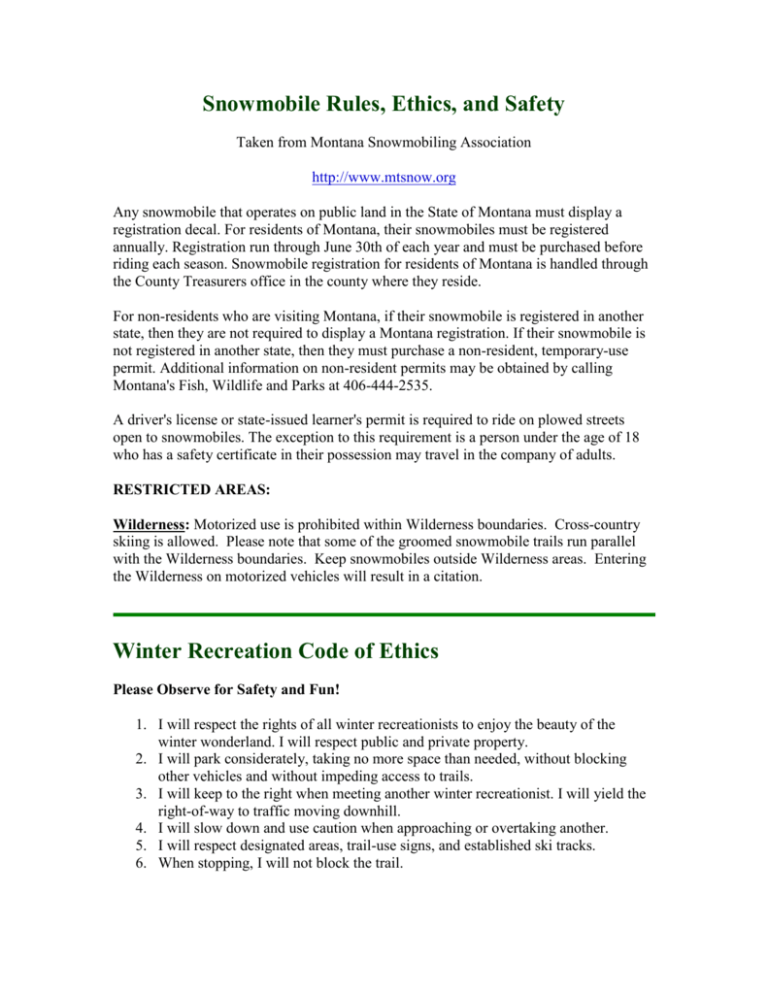
Snowmobile Rules, Ethics, and Safety Taken from Montana Snowmobiling Association http://www.mtsnow.org Any snowmobile that operates on public land in the State of Montana must display a registration decal. For residents of Montana, their snowmobiles must be registered annually. Registration run through June 30th of each year and must be purchased before riding each season. Snowmobile registration for residents of Montana is handled through the County Treasurers office in the county where they reside. For non-residents who are visiting Montana, if their snowmobile is registered in another state, then they are not required to display a Montana registration. If their snowmobile is not registered in another state, then they must purchase a non-resident, temporary-use permit. Additional information on non-resident permits may be obtained by calling Montana's Fish, Wildlife and Parks at 406-444-2535. A driver's license or state-issued learner's permit is required to ride on plowed streets open to snowmobiles. The exception to this requirement is a person under the age of 18 who has a safety certificate in their possession may travel in the company of adults. RESTRICTED AREAS: Wilderness: Motorized use is prohibited within Wilderness boundaries. Cross-country skiing is allowed. Please note that some of the groomed snowmobile trails run parallel with the Wilderness boundaries. Keep snowmobiles outside Wilderness areas. Entering the Wilderness on motorized vehicles will result in a citation. Winter Recreation Code of Ethics Please Observe for Safety and Fun! 1. I will respect the rights of all winter recreationists to enjoy the beauty of the winter wonderland. I will respect public and private property. 2. I will park considerately, taking no more space than needed, without blocking other vehicles and without impeding access to trails. 3. I will keep to the right when meeting another winter recreationist. I will yield the right-of-way to traffic moving downhill. 4. I will slow down and use caution when approaching or overtaking another. 5. I will respect designated areas, trail-use signs, and established ski tracks. 6. When stopping, I will not block the trail. 7. I will not disturb wildlife. I will avoid areas posted for the protection of feeding wildlife. 8. I will pack out everything I packed in and will not litter. 9. I realize that my destination objective and travel speed should be determined by my equipment, ability, the terrain, weather and the traffic on the trail. In case of emergency, I will volunteer assistance. 10. I will not interfere with or harass others. I recognize that people judge all skiers or snowmobilers by my actions. Safety Tips What To Take 1. Take a winter first aid kit. 2. Take matches and a fire starter in a waterproof container. 3. Take extra food and water. 4. Take extra clothing, including a wool or synthetic sweater, gloves and a rain shell. 5. Take a plastic whistle. 6. Take a map and compass and, if possible, a GPS reciever. 7. Take a flashlight with extra batteries and bulb. 8. Take an emergency reflective rescue blanket. 9. Take a pocket knife. 10. Take an avalanche cord or transceiver and breakdown probes when in avalanche country. 11. Take a mobile phone or radio transceiver for back country emergency communication. What to Know How to stay calm in an emergency. How to do basic maintenance and adjustments of your equipment, particularly snowmobiles. When to use good judgment to avoid risks and hazards. Where you are at all times. One of the ways that the Montana Snowmobile Association has promoted safety is they have worked for several years with Life Link International to promote safety awareness by selling safety equipment. If you are a MSA member or would like to become one and would like to purchase any of the safety equipment then click here for the Life Link form and print the included order blank and mail it to the address listed with payment enclosed. Thank you. Winter Travel A Different World Many people are unaware of the hazards of winter travel. Harsh conditions of wind, cold, snow, or whiteout can turn an outing into a tragedy. Knowledge of the area, weather, route and the limitations of your body and equipment—plus a little common sense—can ensure a safe and enjoyable trip. Where To Go? Most of the National Forests land is open for unrestricted winter travel. General recreation map and information is available at Forest Service offices. Winter Road Conditions You will encounter a wide range of road condition during the winter months, including dry pavement, black ice, hard packed snow, ice, loose snow, slush, and every combination. Roads to winter destinations may be plowed periodically. However, road conditions may often be very difficult even after plowing. The typical standard for higher elevation, unpaved roads is single-lane with turnouts and a 2-inch cushion of snow/ice on the roadway to protect the gravel surface. Be prepared! High-clearance vehicles with 4wheel drive and good mud/snow tires are best. Other vehicles, especially RV’s, may find the going very difficult at times. Be especially careful going downhill when there is packed snow and ice! Some areas may be plowed to a higher standard. Call your local Forest Service office if you have questions. Share The Country The National Forest is vast, but in some areas those traveling by skis, snowshoes, and snowmobiles must share the same routes and areas. Common sense and courtesy will provide a safe and pleasant experience for everyone. The following suggestions are for your benefit. Snowmobiles should operate at minimum speed near skiers or snowshoers. Do not accelerate until well beyond those on foot. Skiers and snowshoers should yield the track to oncoming or overtaking snowmobilers, unless the track is wide enough for safe passage. Snowmobiles are not usually permitted on developed ski areas. Ski touring and snowshoeing may be restricted or regulated. Check with the local Ranger or ski area manager. Leave Word Before you leave, notify a responsible person of: Your planned route of travel. Mark it on a map for them. Your planned departure time. Your planned time of return—be sure to check back in. When someone is overdue, keep calm. Notify the County Sheriff in the trip area. The county Sheriff will then take steps to alert or activate the local search and rescue organization. If the missing person returns later, be sure you advise the Sheriff. Clothing and Equipment Layers of clothing which can be adjusted to prevailing conditions are best. A goodquality rain gear is excellent. Avoid tight fitting clothes and boots that may restrict circulation. Take extra socks and gloves or mittens, warm cap, matches in a waterproof container, firestarter, nylon cord, general purpose knife, high-energy food, plastic tarp, space blanket, signal mirror, first aid kit, wide tape for repairs and metal container for melting snow. Snowmobilers should be certain to have wrench pliers, extra sparkplugs and drive belt, and a spare ignition key. Experienced snowmobilers always carry snowshoes (in case of machine failure), as well as the normal emergency and survival gear for winter. Don't Get Lost Avoid getting lost by: Taking a good map Learning to read it and knowing how to locate your position Learning to read a compass and believing it Checking weather forecasts and avoiding storms It is easy to become disoriented in whiteouts and when physically exhausted. Hypothermia Frostbite is caused by exposure of inadequately protected flesh to subfreezing temperatures. Tissue damage is caused by the reduced blood flow to the extremities, as opposed to hypothermia, which causes lowering of the body’s rate of metabolism. SYMPTOMS: Uncontrollable fits of shivering Vague, slow, slurred speech Memory lapses, incoherence Immobile, fumbling hands, lurching walk, stumbling Drowsiness (TO SLEEP IS TO DIE) Apparent exhaustion, inability to get up after a rest First line of defense: Avoid exposure, stay dry, BE AWARE OF THE WIND, understand and don’t underestimate the cold. Second line of defense: Terminate exposure get out of the wind and the rain, and build a fire, NEVER IGNORE SHIVERING FORESTALL EXHAUSTION. IF POSSIBLE, APPOINT A FOUL-WEATHER LEADER. Third line of defense: Watch yourself and others for the symptoms listed above. Fourth line of defense: TREATMENT Get victim out of the wind and rain Strip off all wet clothes. If patient is only mildly impaired Give the person warm drinks Get the person into dry clothes and warm sleeping bag. If the person is semi-conscious, try to keep awake. Give the person warm drinks. Leave them stripped, put in sleeping bag with another person (also stripped). Skin to skin contact is the most effective. Build a fire to warm the camp. Altitude Sickness At 10,000 feet, air contains only two-thirds the oxygen it has at sea level. In addition, the higher air pressure at sea level easily forces the available oxygen through the thin lining of the lungs into the bloodstream. At high elevations, there is less air pressure and the available oxygen is not so easily forced through the lung walls. SYMPTOMS: Listlessness, loss of appetite, weakness, apathy, nausea, dizziness and drowsiness. TREATMENT: Stop and rest, breathe deeply a few times, and obtain nourishment from simple sugars such as candy or fruit juices. Travel to lower elevation. PREVENTION: Keep in good physical condition and eat a well-balanced diet. Avoid sudden trips to high altitudes requiring immediate physical exercise. Drink plenty of water. Hyperventilation SYMPTOMS: This reaction to altitude is caused by breathing that is too rapid and a decrease of the carbon dioxide level in the blood, causing light-headedness and cold feeling. Victims are apprehensive and excited. PREVENTION: Same as altitude sickness. Nutrition A good rule is "lightweight but loaded," meaning loaded with calories. Plan your meals to ensure a balanced diet of high-energy foods. Take along plenty of snacks. Water is often difficult to find in winter. All that is available may be what you take or can melt. Replacement of fluid is very important for maintaining physical condition. Sanitation What you carry in, please carry out. Take food in easily compressed packages, such as foil, that requires little space in your gear. Avoid leaving human waste near any water source. If you are in a group, avoid concentrating wastes. Nature can assimilate only small quantities at a time. Bury solid waste 6 inches underground. Wind Chill Factor m.p.h Equivalent Temperature on Exposed Flesh W i n d 40 1 -4 -15 -22 -29 -36 -45 -54 -62 -69 -76 -87 -94 35 3 -4 -13 -20 -27 -35 -34 -52 -60 -67 -72 -83 -90 30 5 -3 -11 -18 -26 -33 -41 -49 -56 -63 -70 -78 -87 25 7 0 -7 -15 -22 -29 -37 -45 -52 -58 -67 -75 -83 S p e e d 20 12 3 -4 -9 -17 -24 -32 -40 -46 -52 -60 -68 -76 15 16 11 1 -6 -11 -18 -25 -33 -40 -45 -51 -60 -65 10 21 16 9 2 35 30 25 20 -2 -9 -15 -22 -27 -31 -38 -45 -52 15 10 5 0 -5 -10 -15 -20 -25 Air Temperature (degrees Fahrenheit) Winter Driving Could you and your passengers survive being stranded in a severe winter storm? Every year we hear about the plight of motorists caught on the road during a severe blizzard or storm. The results can be traumatic and/or fatal unless you are prepared. Consider the following when preparing your vehicle for winter travel: BATTERY AND ELECTRICAL SYSTEM: A battery that’s 100-percent efficient at 80 degrees will be only 64-percent efficient at 30 degrees, and only 33-percent efficient at 10 degrees. FUEL AND IGNITION SYSTEMS: How long has it been since your vehicle had a tune-up?. Periodic tune-ups can find those items that should be replaced to prevent failure in cold weather. Also, check the entire exhaust system for leaks. COOLING SYSTEM: Be sure that the system is clean, that you have adequate antifreeze protection, and that all hoses and belts are in good condition. Antifreeze should be replaced every two years. OIL: Clean oil of the correct weight, or viscosity, is important to cold weather starting. TIRES: Tire tread condition is crucial when driving on ice and snow. A minimum of 5/32" of tread is necessary to provide good traction. Also check inflation. Tire pressure decreases one pound for every 10-degree drop in temperature. Radial "all-weather" tires are recommended. Studded snow tires provide better traction on snow, while chains are best for stopping and starting in severe snow and ice conditions. WINDSHIELD WIPERS AND LIGHTS: Keep plenty of windshield-washer antifreeze solution in the reservoir. WINTER SURVIVAL KIT: Another precaution is to create a winter survival kit. Use a container for safe and handy storage in summertime, and when fall arrives place in trunk of vehicle. Consider the following items: Blankets, sleeping bags, or something to keep you warm. Extra stocking caps and mittens for passengers, and extra outer clothing. Matches, candles, 2 cans of Sterno (Portable heating fuel for cooking + heat). Two three-pound coffee cans, or the like one for excrement and the other to hold candle or Sterno. Food supply (high-calorie, nonperishable food such as canned nuts, dried fruit, "Trail mix"). Liquids (place in thermos to avoid freezing). Paper towels Small sack of sand or kitty litter for traction. Tire chains (correct size!) Small plastic tarp or blue foam ground cover for putting on tire chains. Shovel (small collapsible type or small snow shovel). Windshield scraper/brush for snow removal. Portable radio with extra batteries. Lock de-icer. Windshield cover (help avoid scraping windshield, easier snow removal). Extra windshield washer antifreeze solution. Map(s) of area you will be traveling. THINGS TO KEEP IN THE CAR YEAR ROUND: Battery jumper cables, flashlight with extra batteries. Tools: screwdrivers, wrenches, pliers, wire, duct tape, socket set, tow chain, First Aid kit with pocket knife, flares/reflective triangles, spare fuses, headlight and taillight bulbs, an extra quart of motor oil, fire extinguisher, cotton work gloves, shop towel, distress flag or help sign.




